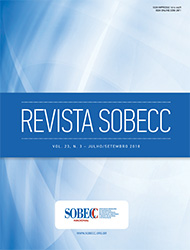Death of intensive care patient in the post-anesthesia care unit: a decontextualized experience
DOI:
https://doi.org/10.5327/Z1414-4425201800030004Keywords:
Sala de recuperação, Período de recuperação da anestesia, Enfermagem em sala de recuperação, Enfermagem perioperatória, Cuidados intensivos.Abstract
Objectives: To identify and characterize the profile of intensive care patients who progressed to death during their stay in the post-anesthesia
care unit (PACU), and list the difficulties faced by the nursing staff. Method: This is a retrospective study that uses the medical records and PACU record
books of five years (from July of 2012 to July of 2017) from a public hospital in Rio Grande do Sul as information source. Results: In the period under
study, 30 intensive care patients died in the PACU, most of them male, with a mean age of 50.97 years, who remained in bed, on average, for 14.8 hours,
and belonged to the neurosurgery specialty. The most frequent cause of death was cardiorespiratory arrest. Conclusion: The admission of intensive care
patients in the PACU requires adjustments in the physical and operational structure of the unit, staff in sufficient numbers and with appropriate technical
training to ensure safe and humanized assistance to intensive care patients, as well as other patients in the postoperative period.
References
REFERÊNCIAS
B eraldo LM, Almeida DV, Bocchi SCM. Da frustração ao
enfrentamento do cuidado para a morte por técnicos de
enfermagem. Rev Bras Enferm. 2015;68(6):1013-9. http://dx.doi.
org/10.1590/0034-7167.2015680603i
M ota MS , Gomes GC, Coelho MF, Lunardi Filho WD, Sousa LD . Reações
e sentimentos de profissionais da enfermagem frente à morte dos
pacientes sob seus cuidados. Rev Gaúcha Enferm. 2011;32(1):129‑35.
http://dx.doi.org/10.1590/S1983-14472011000100017
S ilva RS, Campos AER, Pereira A. Cuidando do paciente no
processo de morte na Unidade de Terapia Intensiva. Rev Esc
Enferm USP. 2011;45(3):738-44. http://dx.doi.org/10.1590/
S0080-62342011000300027
Silva RS, Pereira A, Mussi FC. Conforto para uma boa morte:
perspectiva de uma equipe de enfermagem intensivista. Esc Anna
Nery. 2015;19(1):40-6. http://dx.doi.org/10.5935/1414-8145.20150006
N ascimento P, Jardim DP. Pacientes de cuidados intensivos
em leito de retaguarda na recuperação pós-anestésica. Rev
SOBECC. 2015;20(1):38-44. http://dx.doi.org/10.5327/
Z1414-4425201500010005
S araiva EL, Sousa CS. Pacientes críticos na unidade de recuperação
pós-anestésica: revisão integrativa. Rev SOBECC. 2015;20(2):104‑12.
http://dx.doi.org/10.5327/Z1414-4425201500020006
Souza TFM, Jardim DP. Assistência de enfermagem em leitos de retaguarda
na recuperação pós-anestésica. Revista SOBECC. 2011;16(2):43-9.
L ima LB, Rabelo ER. Carga de trabalho de enfermagem em unidade
de recuperação pós-anestésica. Acta Paul Enferm. 2013;26(2):116‑22.
http://dx.doi.org/10.1590/S0103-21002013000200003
P opov DC , Peniche AC . Nurse interventions and the complications in the
post-anesthesia recovery room. Rev Esc Enferm USP. 2009;43(4):946‑54.
http://dx.doi.org/10.1590/S0080-62342009000400030
Bussab WO, Morettin PA. Estatística básica. 8ª ed. São Paulo: Saraiva; 2013.
L ima LB, Borges D, Costa S, Rabelo ER. Classification of patients
according to the degree of dependence on nursing care and illness
severity in a post-anesthesia care unit. Rev Latino-Am Enferm.
;18(5):881‑7. http://dx.doi.org/10.1590/S0104-11692010000500007
S ilva RM , Silva BA , Silva FJ, Amaral CF. Ressuscitação cardiopulmonar
de adultos com parada cardíaca intra-hospitalar utilizando o estilo
Utstein. Rev Bras Ter Intensiva. 2016;28(4):427-35. http://dx.doi.
org/10.5935/0103-507x.20160076
A ssociação Brasileira de Enfermeiros de Centro Cirúrgico, Recuperação
Anestésica e Centro de Material e Esterilização. Diretrizes de práticas
em enfermagem cirúrgica e processamento de produtos para a
saúde. 7ª ed. São Paulo: SOBECC / Barueri: Manole; 2017.
Downloads
Published
How to Cite
Issue
Section
License
By publishing in Revista SOBECC, authors retain the copyright of their article and agree to license their work using a Creative Commons Attribution (CC BY 4.0) International Public License, thus accepting the terms of this license. The CC BY 4.0 license allows others to distribute, remix, adapt, and create from the published article, even for commercial purposes, provided they give due credit to the creators of the work (authors of the article).
The authors grant to Revista SOBECC the right of first publication, to identify itself as the original publisher, and grant to the journal a non-exclusive license to use the work in the following ways: (1) to sell and/or distribute the article in hard copies and/or in electronic format; (2) to distribute parts and/or the entire article in order to promote the journal through the internet and other digital and printed media; (3) to record and reproduce the article in any format, including digital media.
With this license, authors can enter into separate contracts for non-exclusive distribution of the article (e.g., publishing in an institutional repository or as a book chapter), with acknowledgement of authorship and initial publication in Revista SOBECC. Authors are encouraged to publish and distribute their work online after publication in the Revista SOBECC, as this can increase the article's visibility and impact.
In line with the journal's policies, each published article will be assigned a CC BY 4.0 license, which will be visible on the abstract page and in the PDF of each article with the respective link to the license terms.











